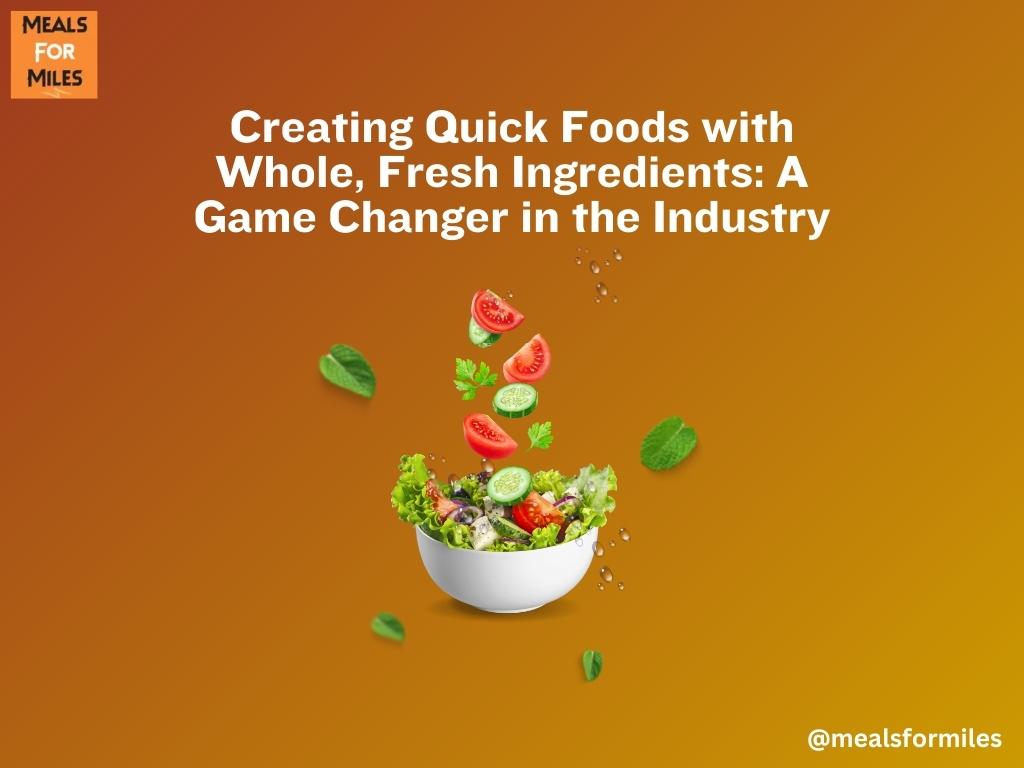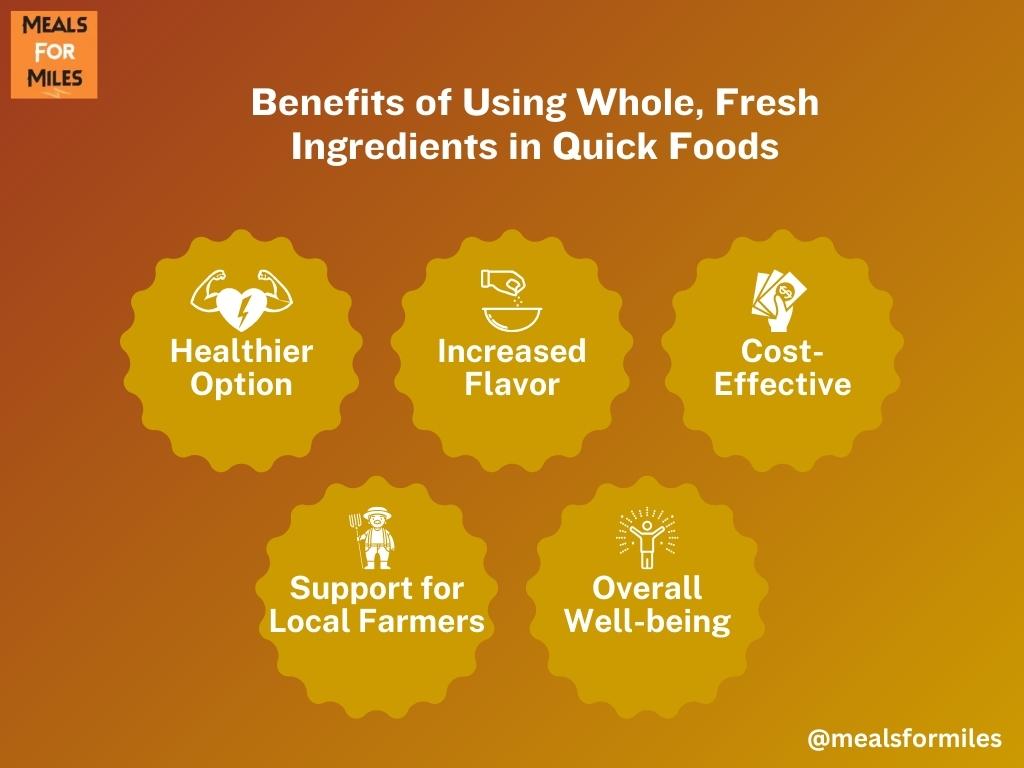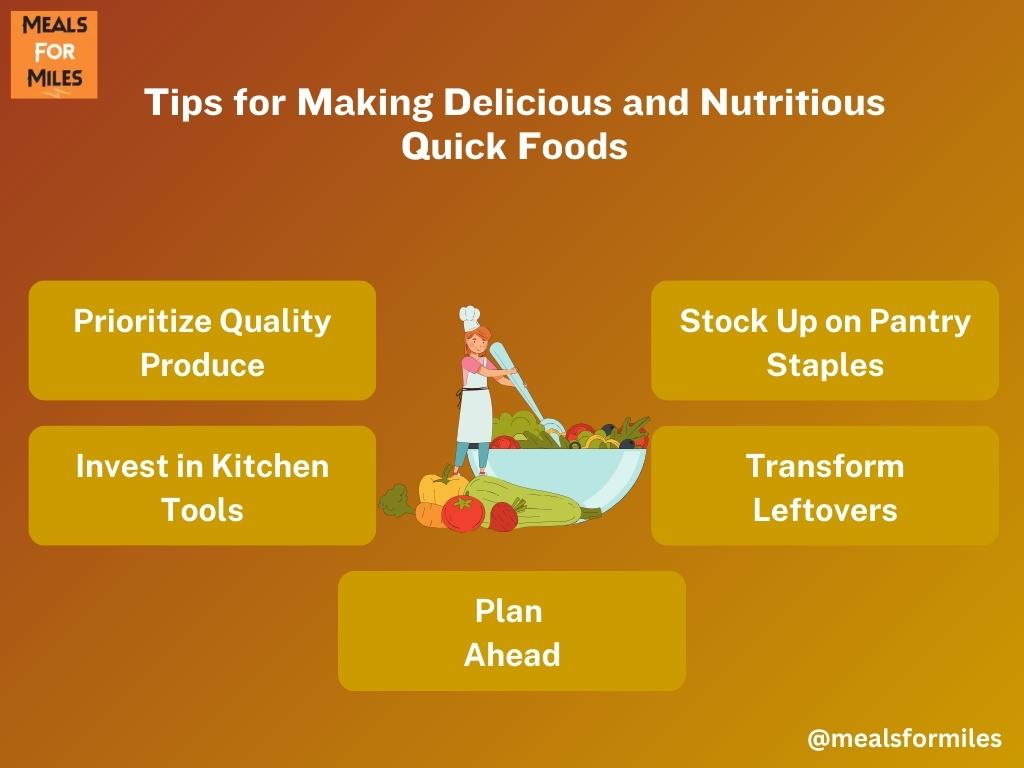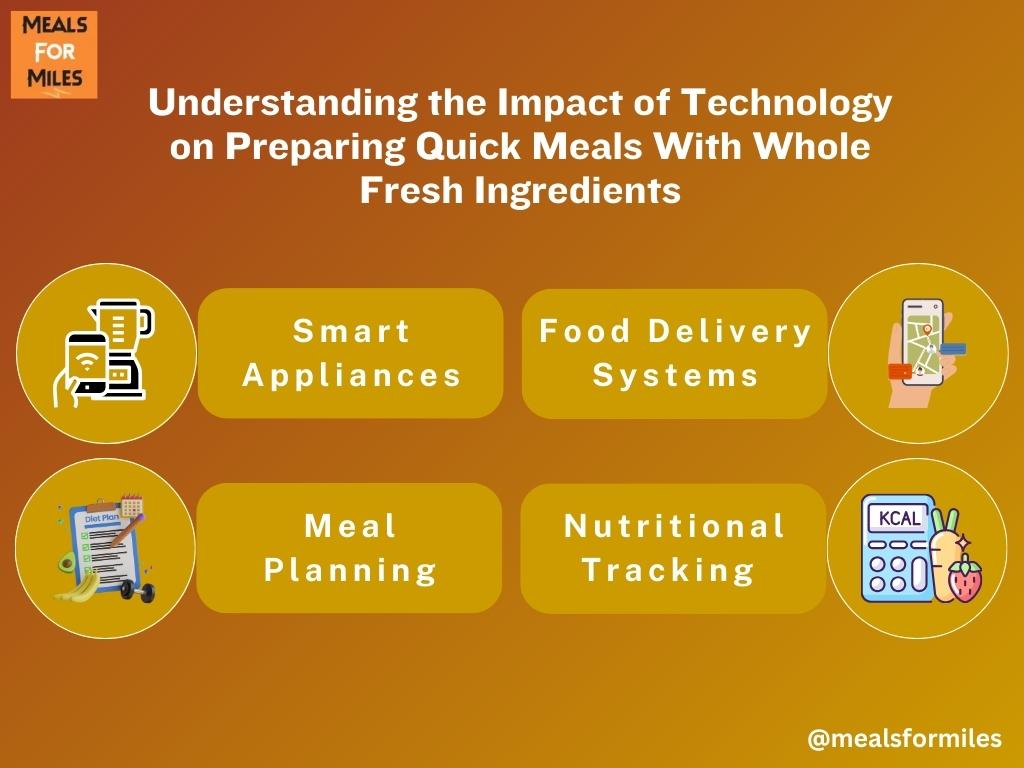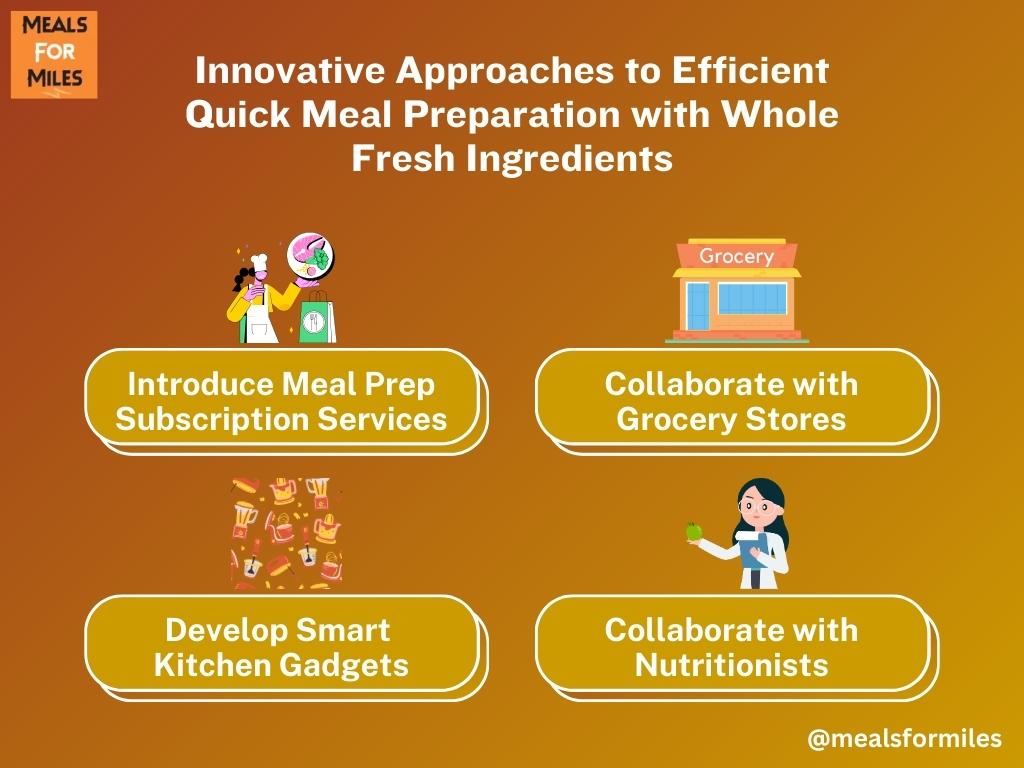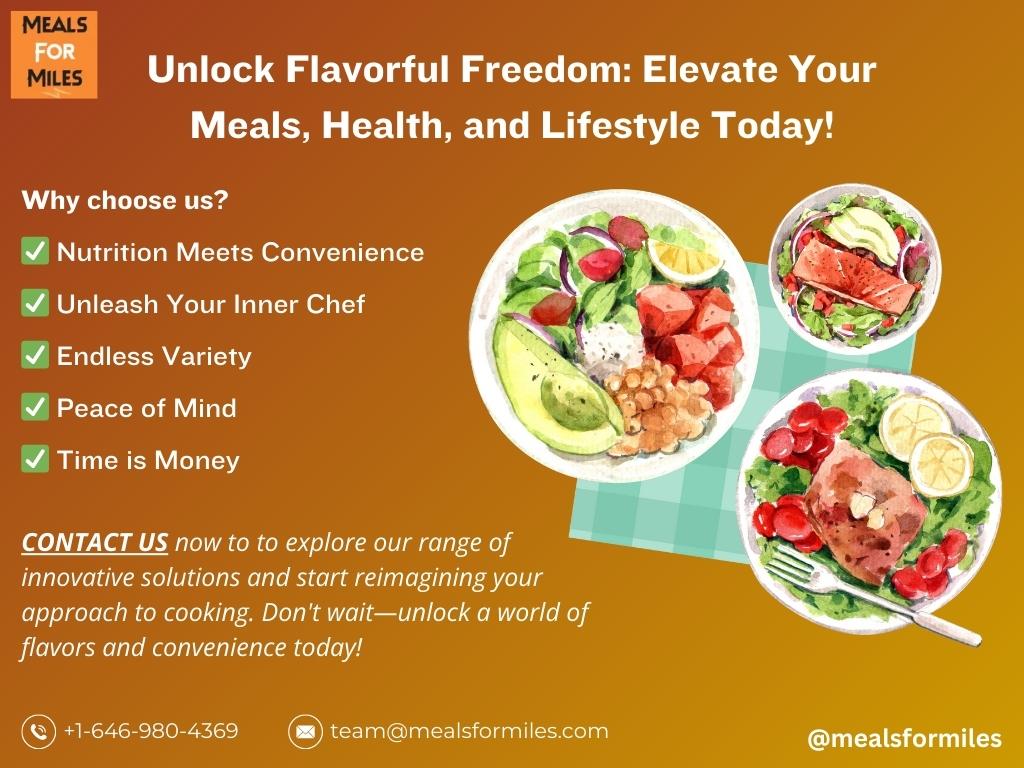Ready to revolutionize your approach to quick, healthy meals with whole, fresh ingredients?
We’re here to help you embrace the future of cooking! Our services and products are designed to simplify your meal preparation, saving you time and effort while ensuring delicious, nutritious results.
In today’s fast-paced world, preparing quick meals with whole, fresh ingredients doesn’t have to be a daunting task. It offers numerous benefits, including higher nutrition, eco-friendliness, and enhanced flavor. Challenges may include time constraints and ingredient sourcing, but tips like joining CSAs and utilizing kitchen tools can help.
Technology plays a pivotal role in expediting meal preparation, with meal delivery kits, kitchen robots, and apps offering support. Creating efficient systems, such as organized workflows and proper equipment maintenance, streamlines the process. Innovative approaches like pressure cookers and slow cookers provide additional options. The future promises even smarter tools and culinary possibilities, making quick, nutritious meals more accessible than ever.
Table of Contents
- Introduction to Quick Foods with Whole, Fresh Ingredients
- Benefits of Using Whole, Fresh Ingredients in Quick Foods
- Challenges of Creating Quick Foods With Whole Fresh Ingredients
- Tips for Making Delicious and Nutritious Quick Foods
- Strategies for Sourcing Quality Whole Food Ingredients
- Understanding the Impact of Technology on Preparing Quick Meals With Whole Fresh Ingredients
- How To Create A System That Streamlines Processes When Making Quick Meals With Whole Fresh Ingredients
- Exploring Innovative Approaches To Preparing Quick Meals With Whole Fresh Ingredients
- The Future Of The Industry: What Can We Expect?
- Final Thoughts: Reimagining The Possibilities With Creating Quick Foods With Whole Fresh Ingredients
Introduction to Quick Foods with Whole, Fresh Ingredients
When it comes to preparing quick meals with whole, fresh ingredients, many people think of labor-intensive recipes and long wait times. However, this doesn’t have to be the case. With the right tools and techniques, creating delicious and nutritious meals with whole foods can be done quickly and easily. Quick foods with whole fresh ingredients offer a game changer in the food industry as they provide convenience without compromising on taste or nutrition.
Benefits of Using Whole, Fresh Ingredients in Quick Foods
Using whole, fresh ingredients in quick meals has several benefits over processed or pre-packaged options. These dishes are typically more nutrient-dense, with higher vitamin, mineral, and fiber content. They are also more environmentally friendly, requiring fewer resources and producing less waste. Additionally, meals made from scratch using quality ingredients are often more flavorful, making them a great option for picky eaters.
- Healthier Option: Using whole, fresh ingredients in quick foods ensures that consumers are getting a higher nutritional value from their meals. Fresh ingredients are packed with essential vitamins, minerals, and fiber, which are essential for maintaining a healthy diet.
- Increased Flavor: Meals made from scratch using quality ingredients have a distinct and flavorful taste that is often lacking in processed or pre-packaged options. This makes them a more enjoyable and satisfying choice for individuals, including picky eaters who may be more willing to try new foods when they are made with fresh ingredients.
- Environmental Sustainability: Choosing whole, fresh ingredients for quick foods can contribute to environmental sustainability. Fresh ingredients require fewer resources to produce and process, reducing the carbon footprint associated with food production. Additionally, using whole ingredients reduces packaging waste, as it eliminates the need for excessive packaging common in pre-packaged meals.
- Customizability: When using fresh ingredients, consumers have the freedom to customize their meals according to their dietary preferences and restrictions. This allows for a more personalized and flexible eating experience, catering to different tastes, allergies, or dietary needs.
- Support for Local Farmers: Opting for whole, fresh ingredients supports local farmers and promotes the growth of local agricultural communities. By purchasing fresh produce, meat, and other ingredients from local sources, consumers can contribute to the local economy and help sustain small-scale farming operations.
- Reduced Risk of Additives and Preservatives: Processed and pre-packaged foods often contain additives, preservatives, and artificial flavors. By using whole, fresh ingredients, quick foods can be made without relying on these unhealthy additives and preservatives, reducing the risk of potential health issues associated with consuming them.
- Increased Food Safety: Preparing quick foods using fresh ingredients allows for better control over food safety practices. Consumers can ensure that their meals are prepared in a clean and hygienic environment, reducing the risk of foodborne illnesses that may be associated with processed or pre-packaged foods.
- Cost-Effective: While it may be assumed that using whole, fresh ingredients would be more expensive, this is not always the case. By utilizing seasonal produce and strategic meal planning, quick meals made from scratch can be cost-effective and even more economical than pre-packaged options.
- Educational Value: Using whole, fresh ingredients in quick foods provides an opportunity for consumers to learn more about nutrition and cooking techniques. This can empower individuals to make healthier food choices and develop essential culinary skills that can be applied in their daily lives.
- Overall Well-being: Making quick foods using whole, fresh ingredients not only benefits physical health but also contributes to overall well-being. Consuming nutrient-dense meals can improve energy levels, enhance mood, and support long-term health goals, leading to a better quality of life.
Challenges of Creating Quick Foods With Whole Fresh Ingredients
Creating quick meals using whole fresh ingredients can be challenging due to time constraints and difficulty in sourcing high-quality produce at an affordable price. Busy lifestyles often limit the time available for food preparation, such as washing produce and chopping vegetables. Additionally, it may require traveling longer distances or paying higher prices for certain items, depending on the availability and seasonality of produce in local stores.
Here are the 10 Strategies to Overcome Challenges in Creating Quick Meals With Whole Fresh Ingredients:
- Developing Efficient Pre-Preparation Techniques: To address the time constraints, you could explore innovative methods to pre-wash, pre-cut, and pre-package fresh ingredients. This could involve partnerships with local farms or utilizing automated processes to minimize the time required for food preparation.
- Implementing Advanced Packaging Solutions: Packaging plays a crucial role in maintaining the freshness and quality of ingredients. You could focus on developing packaging solutions that extend the shelf life of whole fresh ingredients without compromising their nutritional value. This could involve using modified atmosphere packaging or other preservation techniques.
- Collaborating with Local Farmers: Building strong relationships with local farmers can help address the challenge of sourcing high-quality produce at an affordable price. You could work closely with farmers to ensure a steady supply of fresh ingredients, possibly through direct contracts or farmer’s cooperatives. This would not only support local agriculture but also provide consumers with access to fresher produce.
- Emphasizing Seasonal Menu Planning: Seasonality affects the availability and cost of certain ingredients. You could design menus that highlight seasonal produce, aligning their offerings with what is readily available and at a lower cost. This would also promote sustainability and reduce the need for long-distance transportation of ingredients.
- Investing in Technological Advancements: Utilizing technology, such as hydroponics or vertical farming, can help overcome the challenges of sourcing fresh ingredients. You could explore these options to grow produce locally, reducing transportation costs, and ensuring a consistent supply of high-quality ingredients.
- Educating Consumers: You could play a role in educating consumers about the benefits of using whole fresh ingredients and the importance of investing time in food preparation. This could involve providing cooking tips, recipe ideas, and demonstrating time-saving techniques to encourage consumers to prioritize healthy, quick meals made from scratch.
- Exploring Partnerships with Meal Kit Delivery Services: Collaborating with meal kit delivery services can offer consumers a convenient solution for quick meals made with whole fresh ingredients. Work with these services to ensure the sourcing of high-quality produce and provide guidance on meal preparation techniques.
- Supporting the Development of Community Gardens: Encouraging the establishment of community gardens can help address the challenge of sourcing fresh ingredients at an affordable price. You could support and promote these initiatives, which would not only provide access to locally grown produce but also foster community engagement and education around healthy eating.
- Engaging in Research and Development: Invest in research and development to discover new methods of preserving and processing whole fresh ingredients, allowing for longer shelf life without sacrificing quality. This could involve exploring innovative techniques such as freeze-drying or developing new packaging materials.
- Collaborating with Food Technology Startups: Keeping up with the latest advancements in food technology can help address the challenges of creating quick meals with whole fresh ingredients. Partner with startups that develop innovative solutions for food preparation, sourcing, or preservation, leveraging their expertise to enhance the overall process.
Tips for Making Delicious and Nutritious Quick Foods
To make delicious and nutritious quick meals, it is important to have access to quality produce. Researching local markets or farms that offer organic options is recommended. Stocking up on pantry staples like dried herbs and spices can add flavor without adding extra calories. Investing in kitchen tools like blenders and food processors can make meal prep easier and faster. Utilizing leftovers by transforming them into new creations can save time and money. Planning ahead is also suggested.
- Prioritize Quality Produce: Seek out local markets or farms that offer organic options. Fresh and high-quality produce not only tastes better but also provides more nutrients for your quick meals.
- Stock Up on Pantry Staples: Dried herbs, spices, and condiments can add flavor to your dishes without piling on extra calories. Keep a well-stocked pantry with a variety of seasonings to enhance the taste of your quick meals.
- Invest in Kitchen Tools: Blenders and food processors can be incredibly useful in speeding up meal prep. They can help you quickly chop vegetables, blend sauces, or make smoothies. Consider investing in these tools to make your cooking process more efficient.
- Transform Leftovers: Instead of letting leftovers go to waste, get creative and transform them into new creations. For example, you can use leftover grilled chicken to make a delicious salad or repurpose cooked vegetables into a flavorful stir-fry. This not only saves time but also reduces food waste and saves money.
- Plan Ahead: Dedicate some time each week to plan your meals in advance. This will help you stay organized and ensure that you have all the necessary ingredients on hand. Consider preparing some components in advance, such as pre-cutting vegetables or marinating meats, to save time during busy weekdays.
- Experiment with Quick Recipes: Expand your repertoire of quick recipes to avoid getting stuck in a cooking rut. Look for creative and nutritious recipes that can be prepared in a short amount of time. Explore different cuisines or try out new ingredients to keep your meals exciting and diverse.
- Emphasize Balance and Nutrition: While speed is important for quick meals, don’t compromise on nutrition. Aim to include a balance of macronutrients (carbohydrates, proteins, and fats) in your dishes. Incorporate a variety of colorful vegetables, lean proteins, and whole grains to ensure your meals are both delicious and nutritious.
By following these tips, you can create a range of delicious and nutritious quick meals that are not only satisfying but also support your overall health and well-being.
Strategies for Sourcing Quality Whole Food Ingredients
To source quality whole food ingredients, it is crucial to build strong relationships with suppliers who prioritize quality and sustainability. This can be done by thoroughly researching and vetting potential suppliers. Direct sourcing from local farmers and producers can also guarantee fresh and reliable ingredients. Regular visits to farms and participation in farmer’s markets can help establish a network of trustworthy sources. Conducting regular quality control checks and audits is essential to maintain consistent standards and identify areas for improvement. By employing these strategies, businesses can ensure they source the best whole food ingredients for their products.
- Collaborate with Local Farmers and Producers: Establish partnerships with local farmers and producers who prioritize quality and sustainability. This allows for direct sourcing of fresh and reliable whole food ingredients.
- Conduct Thorough Supplier Research and Vetting: Before partnering with a supplier, conduct extensive research to ensure they align with your quality standards. Look for certifications such as organic or fair trade, and request samples for testing.
- Visit Farms and Participate in Farmer’s Markets: Regularly visit farms and farmer’s markets to establish a network of reliable sources. This hands-on approach allows you to meet the farmers, understand their practices, and ensure the quality of the ingredients.
- Implement a Quality Control System: Regularly conduct quality control checks and audits to ensure consistent standards are met. This can include testing for contaminants, verifying ingredient authenticity, and monitoring production processes.
- Develop Long-Term Relationships with Suppliers: Building strong relationships with suppliers is crucial for sourcing quality whole food ingredients. Regular communication, feedback, and collaboration can help maintain high standards and address any issues that may arise.
- Embrace Transparency and Traceability: Work with suppliers who can provide detailed information about the origin and journey of their ingredients. This helps ensure transparency and traceability, allowing you to verify the quality and sustainability of the whole food ingredients.
- Stay Updated on Industry Trends and Certifications: Keep abreast of industry trends and certifications related to quality and sustainability. This knowledge can help you identify potential suppliers who are at the forefront of these practices.
- Engage in Community Initiatives: Support local food initiatives and community programs that promote quality whole food production. This not only helps build relationships with suppliers but also demonstrates your commitment to sustainability and supporting local economies.
- Prioritize Education and Training: Invest in educating your team about quality standards, sustainable sourcing practices, and industry developments. This empowers your employees to make informed decisions when sourcing whole food ingredients.
- Continuously Improve and Innovate: Regularly assess your sourcing strategies and seek ways to improve. Stay open to new ideas and innovations in the industry that can enhance the quality and sustainability of your whole food ingredients.
Understanding the Impact of Technology on Preparing Quick Meals With Whole Fresh Ingredients
Advances in technology have had a significant impact on how we prepare meals with fresh ingredients. Digital meal delivery services allow customers to order kits that contain all the necessary components to create healthy dishes quickly. Automated kitchen robots powered by algorithms enable even novice cooks to make great meals with simple commands. Mobile apps track calorie intake and provide real-time feedback on dietary goals. Voice-activated technologies like Alexa devices allow for hands-free operation, making meal preparation faster and more efficient. Overall, these technological advancements have revolutionized the process of creating wholesome meals.
- Smart Appliances: The introduction of smart appliances, such as refrigerators with built-in meal planning apps or ovens that can be controlled remotely, have made meal preparation more convenient and efficient. These appliances can suggest recipes based on the ingredients available, track expiration dates, and even preheat the oven to the required temperature.
- Improved Food Delivery Systems: Technology has greatly improved the efficiency of food delivery services. With the use of GPS tracking and optimized routing algorithms, meals can be delivered quickly and accurately, ensuring that fresh ingredients arrive at the customer’s doorstep in perfect condition.
- Personalized Meal Planning: Mobile apps and websites now offer personalized meal planning services, taking into account individual dietary preferences, nutritional needs, and even allergies. These platforms can suggest recipes, create shopping lists, and track ingredient inventory to reduce food waste and encourage healthier eating habits.
- Robotics and Automation: Automated kitchen robots, equipped with sensors and algorithms, have made it easier for both experienced and novice cooks to prepare meals with whole fresh ingredients. These robots can chop, dice, and cook ingredients with precision and speed, reducing the time and effort required for meal preparation.
- Nutritional Tracking and Feedback: Mobile apps that track calorie intake and provide real-time feedback on dietary goals have become popular tools for individuals looking to monitor their nutrition. These apps can suggest healthier alternatives, track macronutrients and micronutrients, and provide personalized recommendations to help users achieve their health and wellness goals.
- Voice-Activated Technology: Voice-activated devices like Alexa have made hands-free operation in the kitchen possible. Users can now control appliances, access recipe instructions, set timers, and even order groceries through simple voice commands. This technology has made meal preparation more efficient and convenient, allowing individuals to multitask while cooking.
- Enhanced Food Safety: Technology has also improved food safety by introducing smart sensors that monitor temperature, humidity, and expiration dates. These sensors can alert users when ingredients are nearing expiration or when storage conditions are not optimal, ensuring that meals are prepared with fresh and safe ingredients.
- Virtual Cooking Classes: Online platforms and virtual reality technology have made it easier for individuals to learn new cooking techniques and recipes from industry experts. Virtual cooking classes allow users to interact with instructors in real-time, gaining valuable skills and knowledge that can be applied to preparing quick meals with whole fresh ingredients.
- Data-Driven Meal Planning: Advances in technology have enabled data-driven meal planning, where algorithms analyze individual preferences, dietary restrictions, and health goals to suggest personalized meal options. These algorithms can also take into account factors like budget, availability of ingredients, and time constraints, making meal planning more efficient and tailored to individual needs.
- Integration of Smart Devices: The integration of various smart devices, such as smart scales, smart cutting boards, and smart measuring cups, has streamlined the meal preparation process. These devices can provide accurate measurements, track nutritional information, and even suggest recipe modifications based on ingredient substitutions or dietary restrictions.
Overall, the impact of technology on preparing quick meals with whole fresh ingredients has revolutionized the way we cook. From smart appliances to virtual cooking classes, these advancements have made healthy eating more accessible, convenient, and enjoyable for individuals of all skill levels.
How To Create A System That Streamlines Processes When Making Quick Meals With Whole Fresh Ingredients
Creating a system for quick meal preparation with fresh ingredients is important for those who prioritize healthy and convenient cooking. Planning meals in advance and creating a comprehensive grocery list ensures all necessary items are on hand. Organizing the kitchen space and investing in time-saving appliances can speed up meal preparation. Prepping ingredients in advance, such as chopping vegetables or marinating meat, saves time when cooking. By following these strategies, one can easily make nutritious meals quickly without sacrificing quality.
Here are the 10 Strategies for Streamlining Quick Meal Preparation with Whole Fresh Ingredients:
- Introduce a Meal Planning App or Software: Develop a user-friendly app or software that allows users to plan their meals in advance. The app can suggest healthy recipes based on the user’s dietary preferences and generate a comprehensive grocery list.
- Collaborate with Local Grocery Stores: Partner with nearby grocery stores to offer a “quick meal” section where customers can find pre-packaged fresh ingredients specifically designed for quick meal preparation. This saves customers time searching for individual ingredients and ensures they have everything they need.
- Offer Meal Prep Kits: Create meal prep kits that include pre-chopped vegetables, marinades, and portioned-out ingredients for quick and easy cooking. These kits can be sold online or through subscription services, allowing customers to customize their meal choices and have them delivered to their doorstep.
- Develop Time-Saving Kitchen Appliances: Collaborate with appliance manufacturers to design and produce kitchen gadgets that automate time-consuming tasks, such as cutting, slicing, and dicing. These appliances can be marketed as essential tools for streamlining the quick meal preparation process.
- Provide Online Cooking Tutorials: Create a platform or YouTube channel where professional chefs or industry experts can share quick meal recipes and cooking techniques. These tutorials can guide individuals in making nutritious meals with whole fresh ingredients efficiently.
- Create a Community Platform: Establish an online community where users can share their quick meal recipes, tips, and experiences. This encourages engagement and provides a space for users to seek advice from others who prioritize healthy and convenient cooking.
- Offer Personalized Meal Plans: Utilize artificial intelligence and machine learning algorithms to develop personalized meal plans based on an individual’s dietary preferences, allergies, and nutritional goals. These plans can include quick meal options that streamline the cooking process.
- Collaborate with Food Delivery Services: Partner with food delivery services to offer quick meal options using whole fresh ingredients. Customers can order pre-prepared meals that require minimal cooking, saving time and effort in meal preparation.
- Implement Smart Kitchen Organization Systems: Develop smart kitchen storage solutions that help users organize ingredients and kitchen utensils efficiently. This can include smart labeling systems, pantry organizers, and refrigerator compartments designed specifically for quick meal preparation.
- Provide Cooking Workshops and Demonstrations: Organize cooking workshops and demonstrations in collaboration with local community centers or cooking schools. These events can teach participants how to create quick meals with whole fresh ingredients and provide hands-on experience in streamlining the cooking process.
Exploring Innovative Approaches To Preparing Quick Meals With Whole Fresh Ingredients
In today’s busy world, finding time to cook healthy meals is difficult. However, the availability of fresh ingredients has led to new ways of preparing quick meals. These approaches aim to make cooking efficient and enjoyable without compromising nutrition. Meal prep techniques and time-saving kitchen gadgets are used to create wholesome meals without sacrificing taste or quality. By focusing on fresh fruits, vegetables, and lean proteins, individuals can nourish their bodies while saving time. Using tools like Instant Pots and experimenting with seasonal produce allows for endless possibilities in quick meal preparation with whole fresh ingredients.
Here are the 10 Innovative Approaches to Efficient Quick Meal Preparation with Whole Fresh Ingredients:
- Introduce Meal Prep Subscription Services: Companies can offer pre-portioned fresh ingredients and easy-to-follow recipes delivered to customers’ doorsteps, taking the hassle out of meal planning and grocery shopping.
- Collaborate with Grocery Stores: Partnering with local supermarkets to create dedicated sections for whole fresh ingredients, including pre-cut fruits and vegetables, marinated proteins, and ready-to-cook grains, can make it easier for busy individuals to find and prepare healthy meals.
- Offer Virtual Cooking Classes: You can host online cooking classes that teach participants how to prepare quick and nutritious meals using whole fresh ingredients. These classes can provide tips, tricks, and recipe ideas, ultimately empowering people to cook efficiently at home.
- Develop Smart Kitchen Gadgets: Companies can invest in the creation of innovative kitchen gadgets that streamline meal preparation. For example, a multi-functional chopping board with built-in scales, timers, and knife sharpeners can help individuals save time and effort while preparing meals.
- Collaborate with Nutritionists: Partnering with nutrition experts can help develop meal plans and recipes that cater to different dietary needs. By incorporating whole fresh ingredients into these plans, individuals can meet their nutritional goals without sacrificing convenience.
- Integrate AI Technology: Developing AI-powered cooking assistants or recipe apps can provide personalized meal suggestions based on individuals’ dietary preferences and available ingredients. This technology can also help create shopping lists and provide step-by-step instructions for quick meal preparation.
- Expand Salad Bars and Fresh Food Kiosks: Increasing the availability of salad bars and fresh food kiosks in office buildings, shopping centers, and public spaces can offer busy individuals convenient access to whole fresh ingredients for quick meal assembly.
- Collaborate with Fitness Centers: Partnering with gyms and fitness centers can help promote the importance of quick and healthy meal preparation. Providing nutrition workshops and recipe ideas can inspire individuals to incorporate whole fresh ingredients into their post-workout meals.
- Launch Meal Delivery Apps: Creating apps that connect busy individuals with local restaurants or chefs who specialize in preparing quick and healthy meals with whole fresh ingredients can give people more options for convenient and nutritious eating.
- Collaborate with Food Bloggers and Influencers: Partnering with popular food bloggers and influencers can help spread awareness about the benefits of quick meal preparation with whole fresh ingredients. These collaborations can include sponsored content, recipe development, and live cooking demonstrations.
The Future Of The Industry: What Can We Expect?
As technology continues to evolve, new ways to prepare quick and healthy meals utilizing only the highest quality ingredients are sure to follow suit, resulting in a surge of development of smarter tools that make the job easier, faster, and more efficient. The possibilities become virtually endless in terms of creative combinations of flavors and textures never seen before, opening doors to previously unexplored culinary territories with capabilities at unprecedented levels.
Here are the 10 Future Trends and Innovations in the Food Industry:
- Smart Kitchen Appliances: We can expect the development of advanced kitchen appliances that integrate artificial intelligence and machine learning capabilities. These appliances will be able to understand our preferences, dietary restrictions, and cooking skills to suggest personalized recipes and optimize cooking processes.
- 3D Food Printing: The future may bring 3D printers that can create complex and customized food shapes and textures. This technology could revolutionize the way we prepare and present meals, allowing for intricate designs and artistic presentations.
- Personalized Nutrition: With advancements in technology, we will likely see the rise of personalized nutrition solutions. These could include wearable devices that track our nutritional needs in real-time and provide personalized meal recommendations based on our specific dietary requirements and health goals.
- Food Waste Reduction: As sustainability becomes a pressing concern, the industry will focus on reducing food waste. Smart refrigerators and pantries may be developed to monitor food freshness and suggest recipes based on soon-to-expire ingredients. Additionally, there may be innovations in food packaging to extend shelf life and reduce spoilage.
- Virtual Reality Dining Experiences: Virtual reality (VR) technology could enhance the dining experience by creating immersive environments. Diners may be able to transport themselves to different culinary destinations, enjoying the sights and sounds of a specific region while savoring their meals.
- Lab-Grown Meat and Plant-Based Alternatives: The industry is already witnessing a rise in plant-based alternatives and lab-grown meat. In the future, we can expect further advancements in these areas, with even more realistic and sustainable alternatives to traditional animal-based products.
- Automation and Robotics: The use of automation and robotics in the food industry will likely increase, reducing the need for manual labor and streamlining processes. Robots may be employed in areas such as food preparation, cooking, and even front-of-house services, improving efficiency and reducing costs.
- Blockchain Technology for Supply Chain Transparency: Blockchain technology can provide transparency and traceability in the food supply chain. Consumers will be able to verify the origin, quality, and safety of ingredients through decentralized and immutable records, ensuring trust and accountability.
- Augmented Reality Cooking Assistants: Augmented reality (AR) could provide step-by-step guidance during the cooking process. By overlaying virtual instructions onto real-world objects, AR cooking assistants could help users follow recipes, suggest ingredient substitutions, and provide cooking tips.
- Personalized Meal Delivery Services: As technology advances, meal delivery services may become more personalized. AI algorithms could analyze individual preferences and dietary requirements to create tailored meal plans, ensuring that each delivery meets the unique needs and tastes of the consumer.
Final Thoughts: Reimagining The Possibilities With Creating Quick Foods With Whole Fresh Ingredients
With the advancement of technology, creating quick and nutritious foods using whole, fresh ingredients has become easier than ever before. Gone are the days when healthy choices meant sacrificing taste or spending hours in the kitchen. Innovative kitchen gadgets and appliances have revolutionized the way we cook, allowing us to create delicious meals with minimal effort. Traditional chefs are no longer a necessity, as anyone can now experiment and create mouthwatering dishes. As the demand for healthier lifestyles continues to grow, there are endless opportunities to explore and reimagine classic favorites with a modern twist. So, let your imagination run wild as you embark on the journey of recreating beloved dishes in a healthier and more flavorful way.
Contact us now to explore our range of innovative solutions and start reimagining your approach to cooking.
Don’t wait—unlock a world of flavors and convenience today!

